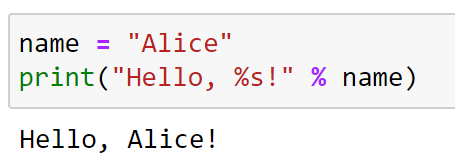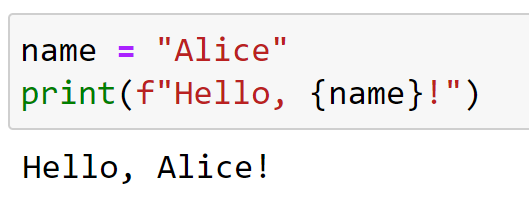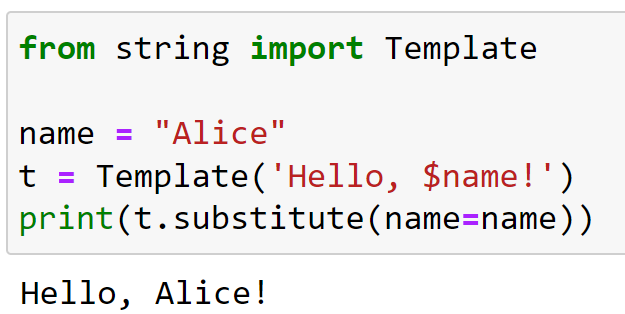Python string interpolation allows you to dynamically modify the content of a string. This process allows for efficient and readable code, as it streamlines the process of updating strings with variable values. In Python, there are several ways to perform string interpolation, each with its own unique syntax and characteristics.
To perform string interpolation in Python, you can use the %-formatting, the format() function, or f-strings. Of these, f-strings offer a concise and efficient way to embed expressions inside string literals. They are defined by prefixing a string literal with ‘f’ or ‘F’, and expressions to be evaluated are written inside curly braces {}. For instance, name = “John”; f”Hello, {name}” would result in the string “Hello, John”.

In this article, we’ll look at 4 different ways of string interpolation in Python. Each method will be accompanied by examples to help you better understand the concept.
Let’s get started!
What is String Interpolation?
String interpolation is a technique in Python that allows you to dynamically insert values into a string.
Contemporary approaches to string interpolation include using the format() function and f-strings. The format() function is a flexible method that enables the use of placeholders in both positional and keyword formats.
F-strings, introduced in Python 3.6, have become the preferred method for many programmers due to their concise syntax, improved readability, and faster execution time.
Python supports multiple ways to perform string interpolation in addition to the format() function and f-strings, such as using the % operator and the Template class. We’ll go over each option in the next section!
4 Methods for String Interpolation in Python
In this section, we’ll look at 4 methods for string interpolation in Python. Specifically, we’ll look at the following:
- String formatting (% Operator)
- String interpolation with Str.format()
- F-Strings (formatted string literals)
- Template strings (string.Template)
Let’s dive in!

1. String Interpolation With String Formatting (% Operator)
This method is inspired by the printf() function in the C programming language.
You use placeholders in the string, represented by %s for strings, %d for integers, etc., and then provide the variables in a tuple after the % operator.
The following is an example of string interpolation with string formatting mechanism:
name = "Alice"
print("Hello, %s!" % name)The output will be:

2. String Interpolation With Str.format()
str.format() provides a flexible and powerful way to format strings.
You can use curly braces {} as placeholders in the string and pass variables in the format() function.
The variables can be referenced by their index, key, or even attribute names if passed objects.
The following is an example of string interpolation with the format function:
name = "Alice"
print("Hello, {}!".format(name))The output will be:

3. String Interpolation With F-Strings (Formatted String Literals)
F-strings is a new string formatting mechanism in Python.
You use curly braces {} inside a string literal prefixed with f or F, and Python evaluates the expressions and substitutes them in place.
The following is an example of Python string interpolation with this method:
name = "Alice"
print(f"Hello, {name}!")The output of the above example will be:

4. String Interpolation With Template Strings (string.Template)
This method is part of the string module and provides another way to substitute placeholders with variable values.
It’s less powerful than the previous methods but can be safer as it avoids issues related to variable injection.
An example of string interpolation with template strings is given below:
from string import Template
name = "Alice"
t = Template('Hello, $name!')
print(t.substitute(name=name)) In this method, you create a Template object with a string and use the $ character to denote placeholders that will be replaced by variable values.
You then call the substitute() method on the Template object and pass in the variables as keyword arguments.
The output will be:

Advanced Formatting Features With Python String Interpolation
Now that you understand the basics of string interpolation, let’s review some more complex examples to help you better understand the concept.
1. Mapping and Dictionaries
One common use case for string interpolation is working with mapping and dictionaries.
The str.format() method and f-strings allow for easy mapping of keys from dictionaries to placeholders in a string.
For example, using str.format() with a dictionary:
person = {'name': 'Alice', 'age': 30}
formatted_string = "My name is {name} and I am {age} years old.".format(**person)The output will be:

You can also use f-strings with a dictionary:
person = {'name': 'Alice', 'age': 30}
formatted_string = f"My name is {person['name']} and I am {person['age']} years old."The output will be:

2. String Prefix and Format Specifiers
Python provides various string prefixes (f,r, and o), which indicate how a string should be formatted or processed.
The f-prefix is used for f-strings, while the r-prefix renders strings as raw, keeping special characters like ‘\t’ as they are.
Format specifiers offer a more fine-grained control over string formatting and can be used in conjunction with %-formatting, str.format(), and f-strings.
They are introduced by the % operator for %-formatting, and with {} for str.format() and f-strings.
For example, format specifiers in %-formatting:
formatted_string = "My height is %0.2f meters." % 1.745In str.format():
formatted_string = "My height is {height:0.2f} meters.".format(height=1.745)With f-strings:
height = 1.745
formatted_string = f"My height is {height:0.2f} meters."The format specifiers are part of a mini-language, which is a compact syntax for describing various formatting options.
Final Thoughts
Understanding string interpolation is of great importance in your Python journey. With the literal string interpolation method, you are empowered to embed Python expressions directly into your strings. This brings your code to life by blending data with text and creates a more readable and efficient codebase.
Python’s support for multiple ways of string interpolation adds a level of versatility to your coding skills. Incorporating these string interpolation methods into your work allows for cleaner code. This leads to code that’s not only more intuitive but also easier on the eyes of both you and other developers who may work with your code.
If you’d like to learn more about Python programming concepts, check out the playlist below:
Frequently Asked Questions
How do you use f-strings in Python?
To use f-strings, simply prefix your string with an ‘f’ or ‘F’ character and use curly braces {} to include expressions or variables inside the string.
For example:
name = "John"
age = 25
print(f"My name is {name} and I'm {age} years old.")What is the difference between f-strings and str.format()?
F-strings and str.format() are both used for formatting strings in Python.
However, f-strings are newer, introduced in Python 3.6, and provide a more concise syntax.
With f-strings, expressions are placed directly inside the string using curly braces {}, while str.format() requires placeholders and the variables are passed as arguments to the format() function.
For example:
# f-string
print(f"My name is {name} and I'm {age} years old.")
# str.format()
print("My name is {} and I'm {} years old.".format(name, age))
How can you escape curly braces in an f-string?
To escape curly braces in an f-string, simply use double curly braces.
For example:
print(f"{{}} is used as a placeholder in f-strings.")What are the benefits of using string interpolation in Python?
String interpolation allows you to embed expressions or variables directly into a string, which improves readability, reduces the amount of code needed, and makes it easier to build dynamic strings.
F-strings, for example, provide a more concise and clear way to format strings compared to other methods, such as %-formatting or str.format().
Can you use expressions inside f-strings?
Yes, you can include expressions inside f-strings by placing them within the curly braces {}. For example:
x = 10
y = 5
print(f"The sum of {x} and {y} is {x + y}.")
How do you format numbers with f-strings?
F-strings allow you to format numbers using various formatting options.
To format a number, include the formatting specifier inside the curly braces {} after the variable or expression using a colon.
For example:
pi = 3.14159265359
print(f"The value of pi rounded to 2 decimal places is {pi:.2f}.")







